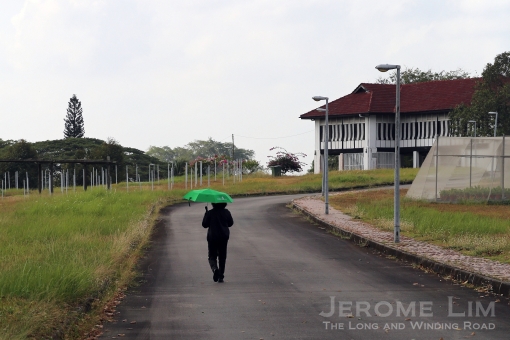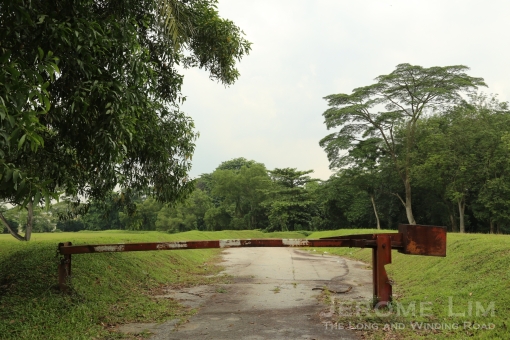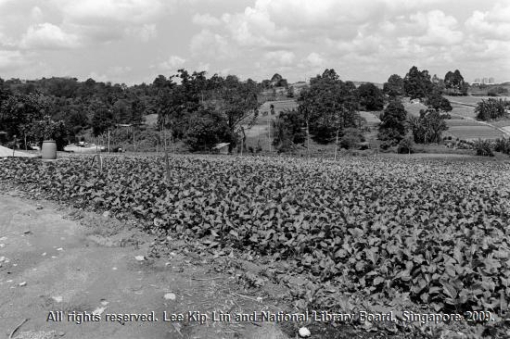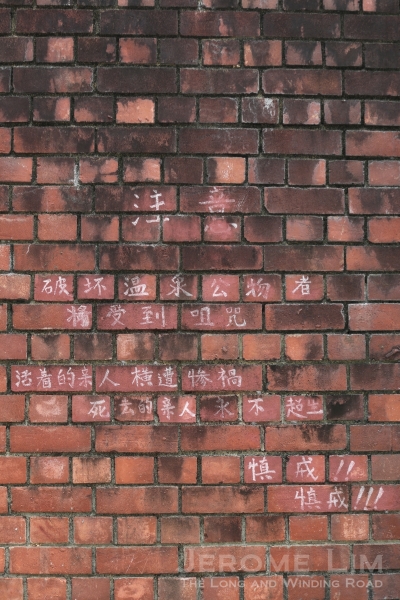Together with several jalan-jalan kaki, I set off on a Sunday morning from Khatib MRT Station in search of a lost countryside. The area in which we sought to find that lost world, is one, that in more recent times has been known to us as Nee Soon and Ulu Sembawang. It was a part of Singapore that I first became acquainted with it in my childhood back in the early 1970s, when an area of rural settlements and village schools that were interspersed with poultry, pig and vegetable farms that awaited discovery along its many minor roads. It was also an area where the British military did leave much in terms of evidence of their former presence.

The group at Jalan Ulu Sembawang in search of a lost countryside.
Fed by the waters of several rivers that spilled out into the Straits of Johor or Selat Tebrau, which included Sungei Seletar and its tributaries, Sungei Khatib Bongsu, Sungei Simpang and its tributaries and Sungei Sembawang, the area was to first attract gambier and pepper plantations in the mid 1800 with which came the first settlements. As with other plantation rich riverine areas of Singapore, the area attracted many Teochew immigrants, becoming one of several Teochew heartlands found across rural Singapore. Rubber (and pineapple) was to replace gambier and pepper in the 1900s – when the association was established with the likes of Bukit Sembawang and Lim Nee Soon, names which are now synonymous with the area, was to start.

Walking through a reminder of the lost countryside at Bah Soon Pah Road.
Much has changed since the days of Chan Ah Lak’s gambier and pepper plantations – for which the area was originally known as Chan Chu Kang, the days of Lim Nee Soon’s involvement as a land owner and in rubber and pineapple processing, and even from the days when I made my first visits to the area. There are however, parts of it that in which some semblance of the countryside that did once exist can be found, parts where one can quite easily find that much needed escape from the concrete and overly manicured world that now dominates the island.

A map of the area showing the location of villages in the area in 1980s (scanned from A pictorial history of Nee Soon Community, 1987)”.
One of two places where those reminders can be found is the area around Bah Soon Pah Road. The road, strange as it may seem, is in fact named after Lim Nee Soon – Bah Soon having been a nickname stemming from him being a Straits Born Chinese or “Baba”. These days, the truncated Bah Soon Pah Road, is still an area that is very much associated with agriculture, being an area that is at the heart of the Agri-food and Veterinary Authority’s (AVA) efforts to promote agrotechnology in Singapore. Playing host to the Nee Soon Agrotechnology Park, there are several farms to be found along the road, including one in which hydroponic vegetables for the local market are cultivated.

Over the fence – a link with the area’s heritage.
An interesting sight along Bah Soon Pah Road is the building that now houses the AVA’s Horticulture Services Centre. The building – a huge bungalow built on stilts, in a style that resembles the “black and white” houses that the British built to house their administrators and senior military men and their families, probably built in the early 1900s with the arrival of the rubber plantations, is in fact a physical link to Lim Nee Soon’s association with the area. Sitting atop a small hill – you do get a magnificent view of it from a distance from Yishun Avenue 1, the grand bungalow was I have been advised, a former residence of the assistant manager of the Bukit Sembawang Rubber Company’s plantation, thus providing a link to a past that might otherwise have been forgotten. The company, was established in 1910, taking over from Sembawang Rubber Plantations Ltd (and Tampenis Para and Coconut Plantations). Lim Nee Soon, who among other things was a rubber a planter, was a consultant as well as the first General Manager of the Sembawang Rubber Plantations.

The AVA’s Horticulture Services Centre at Bah Soon Pah Road occupies a bungalow that served as the Assistant Plantation Manager’s residence in Lim Nee Soon’s estate.
From the west end of Bah Soon Pah Road, we turned north at Sembawang Road – once named Seletar Road. While Seletar today is the area where the former Seletar Airbase, now Seletar Aerospace Park is, Seletar did once refer to a large swathe of land in the north in, particularly so in the days before the airbase was built. The name Seletar is associated the Orang Seletar who inhabited the Straits of Johor, Selat Tebrau, a group of the sea dwellers around the coast and river mouths of northern Singapore and southern Johor from the days before Raffles staked the East India Company’s claim to Singapore. Seletar is a word that is thought to have been derived from the Malay word for strait or selat. Seletar Road, which would have brought travellers on the road to the Naval Base, and to Seletar Pier right at its end, was renamed Sembawang Road in 1939 so as to avoid confusion to road users headed to Seletar Airbase (then RAF Seletar) which lay well to its east.

The road to the former residence.
The drive down Sembawang Road, up to perhaps the early 1980s, was one that did take you through some wonderful countryside we no longer see anymore. One of my first and memorable trips down the road was in a bus filled with my schoolmates – which turned out to be annual affair whilst I was in primary school. The destination was Sembawang School off Jalan Mata Ayer. where we would be bused to, to support the school’s football team when they played in the finals of the North Zone Primary Schools competition.

An old postcard of Lim Nee Soon’s rubber factory further south, and the surrounding area.
The school, the site of which is now occupied by a condominium Euphony Gardens, would be remembered for its single storey buildings – commonly seen in Singapore’s rural areas, as it would be for its football field. The field did somehow seem to have been laid on an incline, a suspicion that was to be confirmed by the difficulty the referee had in placing the ball and preventing it from rolling, when for a penalty kick was awarded during one of the matches.

Sembawang Road at its junction with Jalan Mata Ayer.
The walk from Bah Soon Pah Road to Jalan Mata Ayer, did take us past two military camps. One, Khatib Camp as we know it today, is a more recent addition to the landscape. It would probably be of interest to some, that the original Khatib Camp was one used by the Malaysian military, housing the Tentera Laut Di-Raja Malaysia (TLMD) or Royal Malaysian Navy (RMN) training school KD Pelandok from 1971 to 1980 and was known as Kem Khatib. The Malaysian association with it started in 1964 when it was first set up to house a Malaysian infantry battalion. This came at a time when Singapore was a part of Malaysia.

RMN officers in training at KD Pelandok in Singapore in the 1970s (photograph online at http://farm1.staticflickr.com/167/439314471_c932143651_o.jpg).
Apparently KD Pelandok was where the RMN, who in fact maintained their main base at Woodlands in Singapore until 1979, first carried out their own training of naval officers. Prior to this, naval officers had been sent to the UK to be trained. The camp was returned to Singapore on 2 February 1982, after the training school was shifted to the RMN’s main naval base in Lumut. A new Khatib Camp, now the home of the SAF’s Artillery, was built on the site and the Singapore Armed Forces (SAF) moved into it in 1983.

Sembawang Road looking north from its junction with Bah Soon Pah Road. Khatib Camp is just up the road with Dieppe Barracks across from it. The landscape will very soon change once the construction of an elevated portion of the North-South Expressway starts.

A LTA map of the area showing the North-South Expressway viaduct and an entrance ramp in the vicinity of Khatib Camp. Construction is expected to start next year.
One of the things I remember about the new Khatib Camp in its early days was this helmet shaped roof of its sentry post. Khatib Camp in its early days also housed the SAF Boys School, which later became the SAF Education Centre (SAFEC). The school provided a scheme in which ‘N’-level certificate holders could continue their education fully paid to allow them to complete their ‘O’-levels, after which students would be have to serve a six-year bond out with the SAF. In more recent time, Khatib Camp has been made into one of the centres where NSmen (reservists) would take their annual fitness tests, the IPPT. It is also where the dreaded Remedial Training (RT) programmes are conducted for those who fail to pass the IPPT.

A southward view – there is still perhaps a feel of the countryside there once was in the area.
Across from Khatib Camp, is Dieppe Barracks. Built originally to house British military units with the Far East Amphibious Forces in the 1960s, it is now used by the SAF’s HQ Guards, and is one the last former British army camps to retain the word “barracks” in its name – a reminder of its association with the British forces, and also the New Zealand forces. It housed the 1st Battalion of the Royal New Zealand Infantry Regiment from 1971 to 1989 leaving a distinctly New Zealand flavour on the area as well as in the areas of Sembawang up north. This was as part of the protection force first under the ANZUK arrangements that followed the British pullout in 1971. With the Australian forces pulling out in the mid 1970s, the New Zealanders stayed on as the New Zealand Force South East Asia (NZ Force SEA). One of the things that was hard not to miss on the grounds of the barracks was how different the obstacle course in the open field in the north of the barrack grounds looked from those we did see in the SAF camps then.

At the entrance to Dieppe Barracks in the 1980s, when it was used by 1 RNZIR (online at https://www.seava.co.nz/images/articles/1385013_10152000645703919_605655425_n.jpg).
Just north of Dieppe is where Jalan Mata Ayer can be found (where the school with the inclined football field was). The name “Mata Ayer” is apparently a reference to the source of the now quite well-known Sembawang Hot Springs. The once rural road led to a village called Kampong Mata Ayer, also known as Kampong Ayer Panas, close to the area where the hot spring, now within the boundaries of Chong Pang Camp, is.

Dieppe Barracks in 1975 (image online at http://www.nzhistory.net.nz/media/photo/new-zealand-defence-force-headquarters-singapore, Ministry for Culture and Heritage, updated 31-Jan-2014).
Continuing north along the road, there are several clusters of shophouses across the road from where Yishun New Town has come up. Several shops here do in fact have their origins in the villages of the area. One well known business is a traditional Teochew bakery, Gin Thye Cake Maker. Specialising in Teochew pastries, the bakery goes back to 1964 when Mdm. Ang Siew Geck started it in her village home at Bah Soon Pah Road. Described by The Straits Times as the Last of the Teochew bakeries, its biscuits are a popular choice amongst its customers. You would also be able to spot traditional wedding baskets lined up at the top of one of the shelves. The baskets are used by the bakery to deliver traditional sweets – as might have once been the case, for weddings.

Traditional biscuits right out of the oven at Gin Thai Cake Maker.
Not far up from the shophouses, we come to the area where a relatively new Chong Pang Camp is. The camp sits on what once was a very picturesque part of Singapore, Ulu Sembawang. What was visible of the area from Sembawang Road were the fishing ponds and the lush greenery that lay beyond them. The greenery did obscure an area that did lie beyond it, that was particularly rich in bird life and was up to the 1990s, a popular area for birding activities.

It was an area that we did once get a wonderful view of from Jalan Ulu Sembawang, a road that rose up from close to the back of the then Seletaris bottling plant at its junction with Sembawang Road towards another rural area of villages and farms. The view, from a stretch of the road that ran along a ridge, was what my father did describe as being the most scenic in Singapore that looked across a rolling landscape of vegetable farms for almost as far as the eye could see. Jalan Ulu Sembawang was also one of the roads that led to Lorong Gambas in the Mandai area – an area many who did National Service would remember it as a training area that was used up to perhaps the 1990s.

The end of the road – Jalan Ulu Sembawang used to continue into the Mandai area toward Lorong Gambas.

The rolling hills landscape at Ulu Sembawang in 1993 (photograph: From the Lee Kip Lin Collection. All rights reserved. Lee Kip Lin and National Library Board, Singapore 2009).
A stop along the way that we did spend some time at was the hot springs, around which there seems now to be much superstition. The spring, which was discovered by a municipal ranger on the property of a Seah Eng Keong in 1908. Seah Eng Keong was the son of gambier and pepper plantation owner Mr Seah Eu Chin who I understand from Claire Leow, one half of the female duo who maintains All Things Bukit Brown and who joined us on the walk, also owned gambier and pepper plantations in the area. Seah Eu Chin would also be well known as being the founder of the Ngee Ann Kongsi.

The surviving well of the spring.
The spring water was over the years, bottled in various ways and under various names, first by Mr Seah, and then by Fraser and Neave (F&N) from 1921. One of the names its was bottled as was Zombun which was, on the evidence of a newspaper article, a source of a joke – with waiters referring to “Air Zombun” as a similar sounding “Air Jamban” or water from the toilet in Malay.

Collecting water at the hot springs.

The caretaker splashing himself with water right out of the tap.
Bottling was to be disrupted by the war – the Japanese, known for their fondness for thermal baths, were said to have built such baths at the hot springs – the water, which flows out at around 66 degrees Celcius, with its strong sulphur content (which is evident from the unmistakable smell you would be able to get of it), is thought to have curative properties – especially for skin and rheumatic conditions. It’s flow was disrupted by allied bombing in November 1944 and it was only in 1967 that F&N started re-bottling the water under a subsidiary Semangat Ayer Limited using the brand name Seletaris (now the name of a condominium that sits on the site of the plant).

Now flowing out of pipes and taps, the water comes out at about 66 degrees Celcius.

The hot spring attracts many to it in search of cures for skin ailments and rheumatic conditions.
While it did remain the property of F&N, many were known to have bathed at the spring before 1967 and also again after the plant was closed in the mid 1980s, when its land was acquired by the government. The spring – with water now running out of pipes and taps, in now within the boundaries of Chong Pang Camp – which initially meant that it was closed to the public. Since May 2002 however, after petitions were submitted to the authorities, the spring has been opened to the public. Access to the spring is now through a fenced pathway that cuts into the camp’s grounds. A warning is scribbled on the red brick structure that surrounds a surviving well that speaks of a curse – that anyone who vandalises the hot spring will be the subject of a curse.

The writing on the wall – a curse for any would be vandals.
From the spring and Jalan Ulu Sembawang, now a stub that leads to a wooded area where development doesn’t seem very far away – an international school is already being built there, we can to the end of the adventure. While it is sad to see how another place in Singapore which holds the memories of the gentle world I once enjoyed as a child has been transformed into another place I struggle to connect with; I did at least manage to find a few things that does, in some way remind of that old world that I miss. Developments in the area are however taking off at a furious pace and with the construction of elevated portion of the North-South Expressway that is due to start next year and will have a significant impact on the area’s landscape; it may not be long before it does become another place of beauty that we have abandoned in favour of a cold and overly manicured landscape in which there will be little left, except for “heritage” markers, to remind us of what it did once mean to us.

Jalan Ulu Sembawang is now is an area reclaimed by nature awaiting future development.

Where a school is now being built – the condominium in the background is the Seletaris.





































































I would like to join you kaki some day. Well Done! I always enjoy reading your articles.
Once again Thank You Jerome!
Thanks for your feedback Kasim! And you would be more than welcome to join in the walks … I’ll drop you an email the next time something’s organised. 🙂
Beautiful post! We live in Khatib and Bah Soon Pah is one of my favourite jaunts. Never been to the spring though. Hope to join one of your walkabouts some day! 🙂
Thank you danayong, all thanks to a wonderful part of Singapore I hope we don’t lose to redevelopment soon. You should visit the spring, just for the fact it is the only hot spring ever to have been discovered on the main island. It is always also interesting to observe the people the other visitors to the spring. You are of course welcome to join in the walks – I’ll try to remember dropping you an email the next time we decide to do one. 🙂
Awesome! Fingers crossed too, that development doesn’t touch this precious bit of land, Thank you for recording all this before it potentially changes! 🙂
Doing what I can to help preserve the memory of spaces I find a connection with! 🙂
Hi. Came across ur blog n post as I googled for Jalan Ulu Sembawang.
I had stayed there since born (1975) till 1979. My parents used to rent a small house near the Mama Sarbat Stall (if u can call that now) , where the Mama sold roti prata, mee goreng & rojak. Many workers would have their breakfasts n lunches there in the day. I guess, from where Seletaris Condo is now (Used to be the Telecoms Building), the road to my house is around 7 minutes ahead and then to the right where the sarbat stall was.
I remember my mum used to feed me in the afternoon, sitting at the door and looking towards the Sembawang Air Base where they would do the parachuting practices then. Our water source was the well which was behind our rented house, shared by my parents & the landlord. We reared chickens which we would get the pakcik security at the Telecoms to slaughter them for us during hari raya or once a month.
My trips to the market (now is The Nautical) was previously called Chong Pang and it was a very long n full of greeneries as we had to pass fields before reaching the connecting road.
There used to be a bakery at the now Tyre Shop which sold the most fragrant, yummiest cream cakes ever! My dad was a bus conductor with SBS service 160 & 161, so I would wait for his buses to ‘hitch’ a ride to my paternal grandma’s house at Thomson Road.
My aunt stayed at 14 Miles (Batu 14) & we would take bus 167 to her place. To my maternal grandma’s, we would take 169 and ride through Naval Base. The Home Team area used to be a laundromat, owned & run by the Indians. U would see large bed sheets & blankets being put to dry. The now Sembawang Estate (where the sign is) was where the Police Post & Naval Base Secondary used to be,
Such memories flooded me as I read ur entry. How time has flown….
I would like to thank u for blogging on the most memorable childhood place & which I love, still. I would still showed my children the places and tell them how Singapore was decades ago. I’m just glad there are pictures & blogs like yours which I can refer to, whenever I am in need.
Please dont stop what u are doing…May Allah bless u.
Thanks for visiting the blog and for your words of encouragement, Julia. And, thank you so much for sharing all those wonderful memories … how time has flown! You may also want to visit this post on Chong Pang Village. 🙂 Jerome
Thank you so much for sharing this Jerome Lim & Julia Nah. I was part of NZ Force South East Asia in the early 80s & lived in Jalan Mata Ayer. I am so looking forward to a return to Singapore in 3 weeks time for a holiday. I’m unsure I’ll recognise alot of the old Chong Pang, Sembawang area but your memories give me some key points to look for. Are you doing any walk abouts Jerome during 20-27 Apr 16? Regards Denise
I truly enjoyed reading ur blog….it did really bring back a lot of fond memories….and more nuggets of info on our rich history that few would have known came to light….Thank u for doing all that research to enlighten us…looking forward to more….
I grew up in SUM WAH CHEE DRIVE and studied at WEST HILL SCHOOL, this post bring back so many good memories, it is a trip in itself.
THANK YOU VERY MUCH !